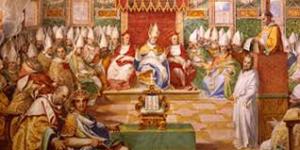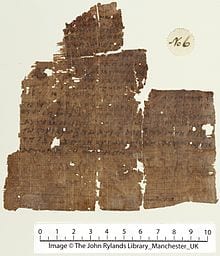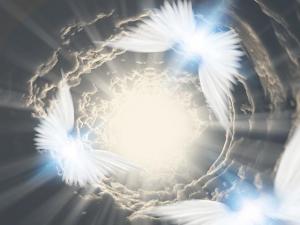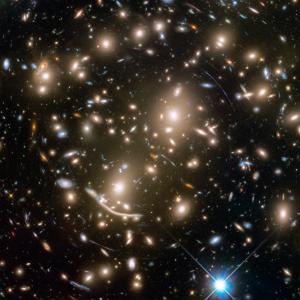
From the Jews we inherit their one God of History and the accompanying worldview of history as a story that is going somewhere. The worldview of the Pagans with their nature gods is with us as well. It shows up in notions of cycles repeating and pendulums swinging back and forth. More positively, it’s in the ideas of balance and sustainability, so difficult and so necessary. After the excesses of modernism, our task is to live in the tension of these two worldviews.
This is the ninth in a series on the Creed of Christians. An introduction consists of my retelling of the Creed’s story. That and links to other posts in the series are here.
Accommodating worldviews in the ancient world
Living with two worldviews is not new. Jews and Pagans had their own worldviews, but each side left at least some room for the other’s point of view.
Greek philosophers and historians were much into nature’s cycles. They saw the cyclical character of the natural world also in human affairs. Hope was deceptive. Whenever it appears in Thucydides, for example, “the reader soon learns that disaster is about to occur.” (This paragraph relies on an article by David Tracy, “Evil, Suffering and Hope.) But then, Tracy says, there are the great tragedians. A Greek play may be a tragedy, but it “can also be an expression of hope—as in Oresteia where we witness the breaking of the cycle of violence and revenge ….”
For the Jews there are the prophets pushing history forward into the unknown. At considerable risk they would urge king and commoner to a new vision of the way things are meant to be but are not yet. But there is also the cycle of the Jewish liturgical year, in tune with seed time and harvest. The images of stars singing and God playing with the sea monster present a natural world that is just what it should be.
Jews and Christians following them rejected the multiple gods of Paganism, but not entirely. Angels became important in Jewish lore from shortly before the time of Jesus. Christians developed an angelology of nine choirs most of which bore striking resemblance to Greek gods and goddesses in their association with natural phenomena.
Modernity and the triumph of history
Nature died at some point in the transition from the Medieval to the modern world. The natural world became the province of science, especially mathematical science. A machine, rather than an organism, was the analogy that suited this world. From stars and the moons of Jupiter to fire, air, water, and earth, matter was the same everywhere in the universe. Mathematical formulas, not teleology, governed its behavior. Galileo found that a light object fell at the same speed as a heavy one. Neither sought the ground because it belonged there.
Spirit intersected with this dead world only at the point of human consciousness. The human body and all animal bodies were machines along with all the rest of the material world.
It was a time for proofs of the existence of God. The universe needed a god, but not as the Medieval Prime Mover or First Cause, operating continuously behind or within all natural, or second, causes. Some force had to get the universe rolling because, How could the world create itself? Once created, though, this world could keep itself going without God’s help. The one God was also a God very much alone. In things that mattered God was not really needed.
Progress, the modern world’s most important product
Evolution and the laws of science propelled the natural world toward the end that God desired. Technology epitomized the human role in this movement. Science had done away with the hierarchy of “the heavens and the earth” and replaced it with space, which is the same all over. Similarly, politics rejected divine support for rule by a few and replaced it with the ideas of freedom, equality, and universal rights.
Economics gave us the promises of capitalism and communism. Philosophy said it could end our dependence on myth and authority and show us reality as it truly is unfiltered by tradition and the limits of our particular time and place.
Every one of these movements aimed at worldwide dominance, and some, especially science and capitalism, basically attained it. The world was becoming united—under the one God, or not. The unifying factor was the desire and apparently realistic hope for a better life in the future, for men and women to be their own saviors.
The future seemed limitless. People believed that the Kingdom of God, with which God had only little to do, was achievable. It was a time of great optimism, the worldly cousin of the theological virtue of hope. But optimism can quickly turn to pessimism. The world was not supposed to go backward, but by the mid-20th century people realized that it could, horribly.
Postmodern critique of modernism
Postmodernism questions every one of the points on which the modern world staked its faith in progress and world unity, including the assumption that unity is worth hoping for in the first place. It questions:
- Modern science. The scientific picture of the world is no less a myth than anything else. Science can’t tell us about reality; it only helps make somewhat reliable predictions about what you’ll observe if you take action X, Y, or Z. (Many but not all scientists agree with this analysis.)
- Technology. There is no such thing as morally neutral technology. Technology is not just a tool we can wield as we choose. It has its own dynamic.
- History and anthropology. Moral progress is a myth disproved by the horrors of the 20th century. There’s no way to judge that one culture is better than another. Even understanding another culture is next to impossible.
- Religion and morality. Historical and cultural studies have shown us many belief systems and many moralities. It’s imperialistic to assume that we’ve discovered the best system and to expect everyone to follow it.
- Politics and economics. The forces of nationalism and ethnic identity, including fundamentalist religions, are dividing our world more efficiently than politics or economics can unite us.
- Modern philosophy. All of our thinking is limited by the particular situation we are brought up in, in other words, by our tradition and our authorities. We look at reality through less-than-transparent cultural windows, of which there are many different shades. There’s no way to look at reality directly.
Worldviews in tension again
To sum up post-modernism: We can’t think alike, and we’ll never act alike; and that’s a good thing. The bewildering variety of nature, with a similar bewilderment of cultures, reasserts itself without any standard for judging worth or progress. Post-modernism can be comfortable with almost anything. It can take or leave God. It can dabble in the para-normal, mysticism, ghosts, even reincarnation, a remarkably anti-body idea for a materialistic world.
But the achievements of modernism are persistent. Freedom, equality, intellectual honesty (if not absolute truth) remain ideals. In a world that is showing its limits, progress is an undefined but still compelling aspiration.
The Jews introduced story and hope into a world of natural cycles. The modern world forsook nature for an imagined story without limits and without a Storyteller, for all practical purposes. If the post-modern return to nature is accompanied by humility, perhaps a productive tension between nature and history, balance and a story with a real climax, can emerge.
Image credit: Youtube via Google Images












